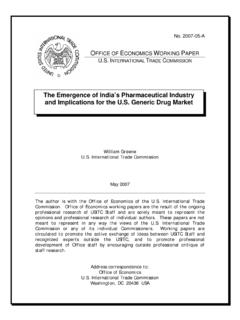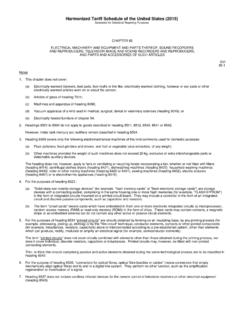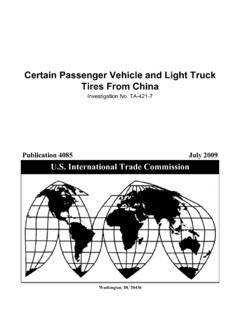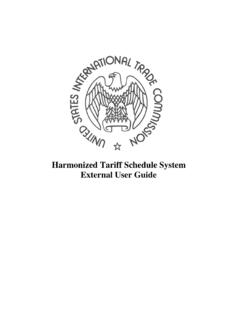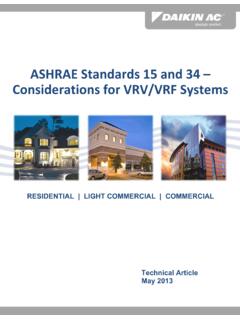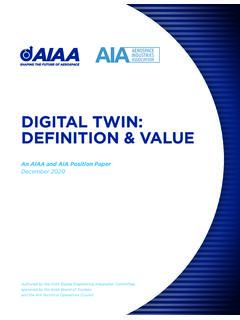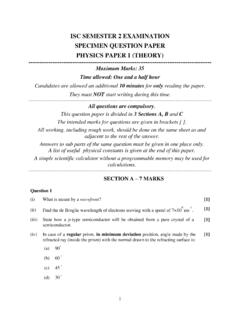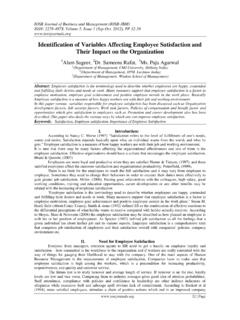Transcription of Global Value Chains: Lithium in Lithium-ion Batteries for ...
1 Office of Industries Working paper ID-069. July 2020. Global Value Chains: Lithium in Lithium -ion Batteries for Electric Vehicles Gregory M. LaRocca Abstract Lithium is an essential material in the production of Lithium -ion Batteries (LIBs), which power electric vehicles. This paper examines the Global Value chain (GVC) for Lithium as part of a series of working papers that map out the Global sources of mining, refining, and Value -added for the key LIB materials. Results show that few countries have economically viable resources of the upstream raw materials that supply the Lithium GVC. Most Lithium -rich ores are exported from Australia to China for processing, while most Lithium brine concentrates are exported from Chile to South Korea, Japan, and China for processing. The large inflows of Lithium to China support its dominant position in the downstream refining process, which is where the largest share of Value -added occurs.
2 Consequently, China is capturing the largest shares of Value -added along the Lithium GVC, despite lacking in resource endowment. Disclaimer: Office of Industries working papers are the result of the ongoing professional research of USITC staff and solely represent the opinions and professional research of individual authors. These papers do not necessarily represent the views of the International Trade Commission or any of its individual Commissioners. International Trade Commission Global Value Chains: Lithium in Lithium -ion Batteries for Electric Vehicles Gregory M. LaRocca Office of Industries International Trade Commission (USITC). July 2020. The author is staff with the Office of Industries of the International Trade Commission (USITC). Office of Industries working papers are the result of the ongoing professional research of USITC staff. Working papers are circulated to promote the active exchange of ideas between USITC staff and recognized experts outside the USITC, and to promote professional development of office staff by encouraging outside professional critique of staff research.
3 This paper represents solely the views of the author and is not meant to represent the views of the International Trade Commission or any of its Commissioners. Please direct all correspondence to Gregory M. LaRocca, Office of Industries, International Trade Commission, 500 E Street, SW, Washington, DC 20436, telephone: 202-205-3405 email: The author would like to thank Pedro Cardenas, Sarah Scott, Robert Ireland and Robert Carr for their review and comments and Monica Sanders and Trina Chambers for their administrative support. International Trade Commission GVC: Lithium in Lithium -ion Batteries for Electric Vehicles July 2020. No. ID-20-069. Global Value Chains: Lithium in Lithium -ion Batteries for Electric Vehicles Introduction This article is one of five working papers in a series dedicated to examining the Global Value chains (GVCs) of the key materials cobalt, Lithium , graphite, and nickel that are critical to the composition of Lithium -ion Batteries (LIBs) that power electric vehicles (EVs).
4 1 Lithium is a strategically important, Global commodity because of its use in Batteries that not only power electric vehicles but also a wide range of personal electronics items. Demand for EV LIBs is a significant factor in the rise in of demand for Lithium , and projections by industry experts attribute most of the future growth in demand for increased Lithium consumption to LIBs used in EVs. 2. Lithium is differentiated in terms of profitable production Lithium production costs vary significantly depending upon the type of raw mineral and Lithium concentration. Although there are several countries with upstream Lithium endowments, there are only a few countries with Lithium resource deposits that can be economically extracted to supply the Lithium GVC. The first supply chain is the largest bilateral trade pattern involving unprocessed Lithium minerals. These unprocessed Lithium minerals are mostly exported from Australia to China where they are refined and then consumed.
5 The second supply chain involves the shipment of processed Lithium compounds which are principally sent from Chile to Japan, South Korea, and China. China holds a dominant role in the downstream refining process, which is where the largest share of Value -added occurs. China's dominance in the downstream refining is a result of aggressive growth by private firms, such as Tianqi and Ganfeng. This working paper examines how and where Lithium is mined and refined. The first section of this paper provides an overview of the role of LIBs in EVs. The second section investigates the attributes and role of Lithium in LIBs. The third section analyzes Lithium market trends and the importance of price. The fourth section examines each of the various Lithium commodity forms identified in table 1. The discussion for each form includes three subsections that explore the form's production processes, production locations and international trade flows, and a case study.
6 Additionally, the production stages that countries and firms participate in are discussed to highlight where the Value -added activities of the GVC occur. There are three geographic case studies covered in the market profile section of each commodity group: the first involves Australia, the largest source of unprocessed Lithium (HS ); the second examines Chile, which is a major source of processed Lithium chemicals (HS and ); and, the third explores China, the world's largest producer of processed Lithium chemicals (HS and ). and refined Lithium compounds (HS , , and ). The last section of the paper discusses Lithium GVC indicators associated with trade. Table 1 shows the three main forms of Lithium discussed throughout this paper . These three forms can be defined at the Global Harmonized System (HS) 6-digit subheading level. The related subheadings are unprocessed Lithium (HS ), referred to as raw stage 1; processed Lithium (HS and ), referred to as raw stage 2; and, refined Lithium products (HS , , and ).
7 1. Forthcoming working papers by the USITC staff in the Natural Resources and Energy Division of the Office of Industries, related to the Global Value chains for four key materials Lithium , cobalt, nickel, and graphite used in the production of Lithium -ion Batteries cell. 2. Jaskula, Mineral Commodity Summary: Lithium , January 2020. International Trade Commission | 1. Working paper ID 069. Table 1 Lithium product forms, by HS subheading and source Form of Lithium (process stage) HS subheading Description Source(s) type Geographic source(s). Unprocessed Other mineral Mine extraction Australia, Lithium minerals substances, not China, Argentina, (raw stage 1) elsewhere specified or Zimbabwe included N/Aa Lithium rich salt Chile, Brine extraction concentrates Argentina Processed Lithium Lithium carbonate Lithium rich ores and Chile, chemicals (raw salt concentrates China stage 2). Lithium oxide and Lithium rich ores or China hydroxide Lithium carbonate Refined Lithium Chlorides, not Lithium carbonate China, compounds elsewhere specified or South Korea, included Japan Other Fluorides, Various Lithium China, fluorosilicates, compounds, such as South Korea, fluoroaluminates and Lithium chloride, Japan other complex fluorine Lithium hydroxide, or salts Lithium fluoride.
8 Alkali metals, other Lithium chloride China, than sodium South Korea, Japan a There are no specific HS numbers differentiating unprocessed salts based upon Lithium content. Unprocessed Lithium rich salt concentrates are not widely traded. Lithium salt concentrates are typically processed at or near extraction operations. b Lithium metals would be imported under this HS subheading. Electric Vehicle Lithium -Ion Batteries Although LIBs power EVs as well as many consumer electronics, EVs are projected to become the dominant end use for LIBs. Consumers' growing demand for EVs is largely driven by their potential to reduce carbon dioxide (CO2) emissions and other pollutants compared to internal combustion engine (ICE) vehicles. In addition, EV demand growth is also partly attributable to declining battery prices and government incentives to defray These lower battery prices reflect LIB cost improvements in the Global supply chain (GSC) for key LIB materials and battery technology innovations.
9 Previous research has examined the importance of EV Batteries (LIBs) and their inputs, including the related supply As noted above, demand for EV LIBs is a significant driver of demand for Lithium and accounts for most of the projected future Lithium used in Batteries accounted for percent of the increased Global demand for Lithium from 2010 to World sales of battery and plug in hybrid EVs reached approximately million vehicles in 2018 (figure 1).7 Rising demand from the automotive industry, 3. Scott and Ireland. Lithium ion Battery Materials and Their Global Value Chains: An Overview. Forthcoming. 4. Coffin and Horowitz, The Supply Chain for Electric Vehicle Batteries , 2018; and Kwon and Ryou, Global Value Chains of East Asia: Trade in Value Added and Vertical Specialization, 2015. 5. Jaskula, Mineral Commodity Summary: Lithium , February 2019. 6. Azevedo et al., Lithium and Cobalt: A Tale of Two Commodities, June 2018.
10 7. Irle, The Electric Vehicle World Sales Database, Ev , accessed August 9, 2019. 2 | Global Value Chains: Lithium in Lithium -ion Batteries for Electric Vehicles particularly in the use of Batteries for EVs, has led to a significant rise and fall in Global prices since 2015. (figures 4 and 5). 8 In 2017, prices for processed Lithium chemicals spiked due to concerns regarding supply constraints. 9 By contrast, during late 2018 and through 2019, prices decreased due to production exceeding demand for Lithium . 10. Figure 1 Electric car deployment in selected countries, 2013 18. 6 Other PHEV. Other BEV. Electric car stock (millions). 5. United States 4 PHEV. United States 3 BEV. Europe PHEV. 2 Europe BEV. 1 China PHEV. China BEV. 0. 2013 2014 2015 2016 2017 2018. Source: IEA, Electric car deployment in selected countries, 2013-2018, retrieved January 22, 2020. Note: BEV refers to a battery electric vehicle without a gasoline-based engine.
